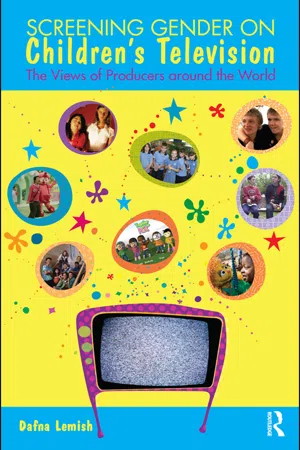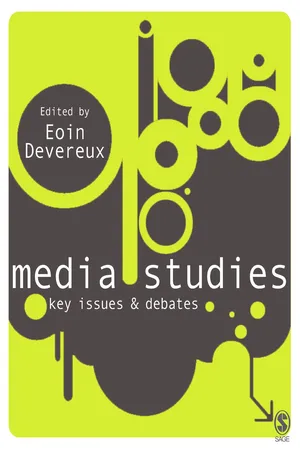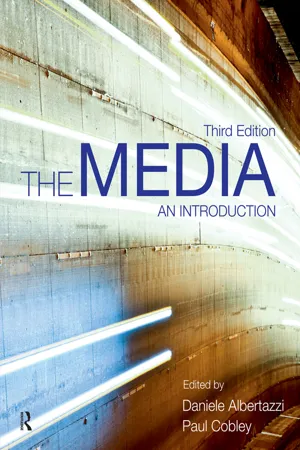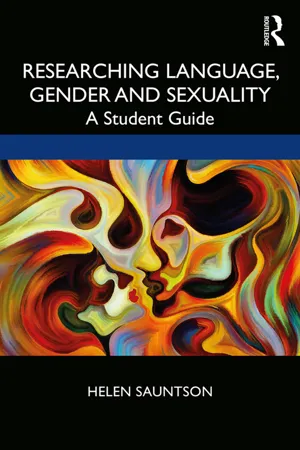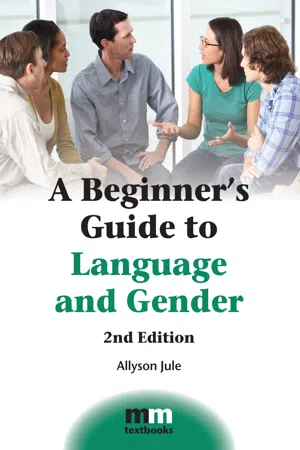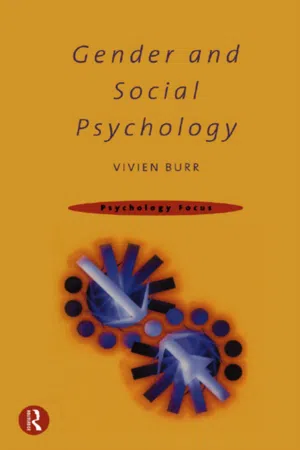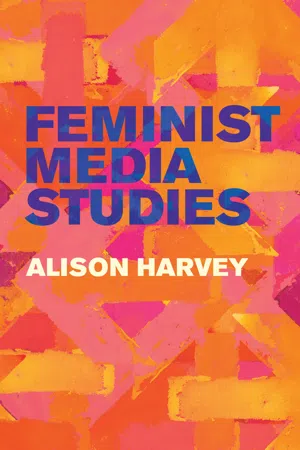Social Sciences
Representation of Gender in the Media
The representation of gender in the media refers to how men and women are portrayed in various forms of media, such as television, film, advertising, and news. This includes examining stereotypes, roles, and expectations associated with each gender, as well as the impact of these representations on society. It is a key area of study within social sciences, exploring the influence of media on shaping perceptions of gender.
Written by Perlego with AI-assistance
Related key terms
10 Key excerpts on "Representation of Gender in the Media"
- eBook - ePub
Screening Gender on Children's Television
The Views of Producers around the World
- Dafna Lemish(Author)
- 2010(Publication Date)
- Routledge(Publisher)
status quo and the general subordination of women by reproducing social perceptions that legitimize dominant ideologies, such as patriarchy (based on gender differences), capitalism (based on economic-class differences), and colonialism (based on ethnic differences).However, given that representations are discursive constructions (i.e. they are realities constructed through discourse), they are not perceived to be enduring practices. Rather, they assume different forms and meanings in different places and times under varied political, cultural, social, and economic contexts, and within diverse ideologies. As a result, gender representations are understood to be dynamic, fluid, changeable, and contested sets of social practices and perceptions. Accordingly, the investigation and analysis of representations serves as a central way to understand gender. And, as advanced by feminist media researchers, such investigations are an important part of the feminist project of problematizing and critiquing ways of knowing, as well as taken-for-granted assumptions about our lives.Representations and Reality
The complex relationships between gender representations and reality have been the focus of much academic debate, particularly in the Cultural Studies tradition, in general, and more specifically the branch that developed in England since the 1950s. The latter tradition, and specifically the Birmingham School, was important in the formation of second wave social and cultural feminist thought, particularly in drawing insights from structuralism and post-structuralism. These approaches take the view that representations do not have an original, authentic “reality” that can be represented or misrepresented accurately (i.e. a concrete reality of being a woman and a concrete reality of being a man), but rather see gender as a form of “performance” involving the acting out of expected social scripts.32 - eBook - ePub
- Rosalind Gill(Author)
- 2015(Publication Date)
- Polity(Publisher)
1Gender and the MediaIntroduction: Representations Matter
WE live in a world that is stratified along lines of gender, race, ethnicity, class, age, disability, sexuality and location, and in which the privileges, disadvantages and exclusions associated with such categories are unevenly distributed. We also live in a world which is increasingly saturated by media and information and communication technologies. In many respects, the last four decades of research in feminist media studies has been an attempt to explore the relationship between these two facts.Starting from the proposition that representations matter, feminist analyses of the media have been animated by the desire to understand how images and cultural constructions are connected to patterns of inequality, domination and oppression. Sometimes this has involved examining representations and textual practices in some detail. Sometimes it has emphasized the active, creative negotiations that audiences make with texts. Sometimes the pleasures offered by the media have been foregrounded, and at other times their ideological impact has been stressed. Occasionally, researchers have gone ‘behind-the-scenes’ to look at the production of particular media, or at the political economy of media industries which means that some media products are made, while others are not even dreamed. Taken together this research has produced a field that is vibrant, exciting and diverse. It is a field that strives to be both theoretically engaged and empirically driven, and which produces rigorous analyses in the context of ethical and political commitments to creating a more just world.The study of gender and media is extraordinarily heterogeneous. Researchers may agree that cultural representations constitute an important site for examination and struggle, but on all else they disagree. The field is thus characterized by a plurality of different approaches and perspectives: different methodologies, different theoretical perspectives, different epistemological commitments, different understandings of power, different conceptualizations of the relationship between representations and ‘reality’, and different understandings of how media images relate to individuals’ sense of identity and subjectivity. A feeling for the differences and debates should emerge throughout this book, and the diversity of different approaches is dealt with in detail in chapter 2 - eBook - ePub
- Vanessa Ratten, Veland Ramadani, Leo-Paul Dana, Robert D. Hisrich, Joao Ferreira(Authors)
- 2017(Publication Date)
- Routledge(Publisher)
Representations of gender The media as the mirror of gender rolesMarlene Loureiro, Galvão Meirinhos, Carmem Leal and Vanessa Ratten1. Introduction
Our society currently believes in the “equality” between Man and Woman; both have the same skills, attitudes, feelings and aptitudes. However, what has been proven is that, as far as their representation and role in society are concerned, there are still traces of stereotypes and traditional roles. In this sense, in this chapter we try to present a brief exploration on the role of the mass media in the communication and transmission of social ideas of gender and of gender roles.The mass media are one of the social and political places of identity construction, and mass media also construct definitions and ideologies of the different age groups, ethnical and social classes, culture and sexual groups (Silveirinha, 2004). In this perspective, we postulate that the media function as a mirror of the society they portray, perpetuating their values, ideologies, laws and norms.Thus, this work of reflection seeks to raise the main research topics related to gender presented in the mass media, with an initial focus on the role of gender in the “positioning” of the viewer. This includes the role of male and female images in the mass media (movies, television, photographs, publicity). Later, the subject of research turns out to be the role played by the mass media in the transmission of patriarchal ideology and the place of women in society. Nowadays, there are more connections between gender studies focusing on gender discourse and gender roles and identities presented and/or conveyed by the media.The issue of gender touches almost every aspect of the relationship between the mass media, society, mass communication and the definition of gender. Therefore, this chapter will cover the following topics:- the media and society;
- gender as social construction;
- studies of gender and feminism;
- the media as the mirror of gender roles.
2. The media - eBook - ePub
Media Studies
Key Issues and Debates
- Eoin Devereux, Eoin Devereux(Authors)
- 2007(Publication Date)
- SAGE Publications Ltd(Publisher)
Media Representations of Social Structure: Gender8
Joke HermesDEFINITIONGender is the cultural significance given to biological difference of reproductive organs. It refers to men and women, as well as to appropriate and less appropriate ways to be a man or a woman (masculinity and femininity). Gender is closely related to sexuality and to difference more generally. Often gender is seen as the ‘original’ difference and as a universal divide in all human groups. This, however, is arguable. There are more than two biological categories. Gender does not assume the same cultural significance everywhere, and gender codes have changed significantly over time. The analytical importance in using gender as a concept is to denote how society is structured in terms of power relations. It points to the huge difference between social categories and the qualities we ascribe to groups. In turn, it is of vital importance to understand that categories never fully describe how actual individuals live their lives.Introduction
This chapter will show why it is important to understand how the media represent gender. It will argue that constructions of femininity and masculinity are part of a dominant ideology that prescribes ‘proper’ behaviour for men and for women (Goffman, 1976; Macdonald, 1995). Central to such proper behaviour is to have the ‘correct’ sexuality. In the Western world dominant ideology, however, is not currently imposed on us dictatorially. There are varieties in proper and less proper ways of being a woman or a man. There is room for different sexualities. The media, in their capacity of informing us about the world and as entertainers, show us an immense range of possibilities and practices of ‘doing gender’. The value attached to these varied possibilities is not equal, nor is it always possible for all of them to be shown. To be or become aware of the many ways in which gender can have meaning, and the weight attached to different forms in different contexts, is what we need to train in order to understand both the media and the societies in which they operate. - eBook - ePub
The Media
An Introduction
- Daniele Albertazzi, Paul Cobley(Authors)
- 2013(Publication Date)
- Routledge(Publisher)
In a consumer society we are constantly exposed to sexually-charged images through advertising. These images predominantly seek not to broaden our attitudes to sexuality, but to persuade us to part with our cash by acquiring products that may enable us to emulate dominant, idealised modalities of sexuality. While the representation of sexuality is obviously not in itself a problem, much mainstream portrayal of it, as in the example of advertising, seems bound by narrow, stereotypical notions of what is acceptable or unacceptable, or of how people ‘should’ experience and express their sexuality. Scholars debate the ways and the extent to which different social groups are influenced by the representations of sexuality they encounter or seek out, but there is general agreement that our sexual behaviour is indeed influenced by what we read and see in the media, which provides a pervasive form of sexual socialisation (Brown 2002). Moreover, the ways in which a particular culture represents sexualities can tell us a great deal about that culture’s priorities, anxieties and concerns. It therefore becomes essential to question the messages embedded in the representations of sexuality by which we are surrounded.Critical discussions of sexuality emphasise its socially-constructed nature: that is, sexual acts, identities and behaviours do not result purely from our biological instincts, nor do they carry a universally valid, fixed meaning. Instead, sexual identities and expressions of sexuality differ in meaning and form depending on the context in which they occur; in other words, cultural contexts influence both how our sense of ourselves as sexual beings is produced, and how, why, where, when and with whom we may choose to engage in, or refrain from, sexual activities of any kind. Gender theory is based on the premise that gender identity (masculinity and femininity) does not derive from our biology, but is formed through a series of culturally imposed, learned acts and behaviours (see Chapter 28 - eBook - ePub
Researching Language, Gender and Sexuality
A Student Guide
- Helen Sauntson(Author)
- 2019(Publication Date)
- Routledge(Publisher)
6 Researching linguistic representations of gender and sexuality in the mediaCameron (2014b) makes an important observation that ‘the media’ isn’t just one thing – it is many things which can include a range of mass media outlets (e.g. TV, radio, newspapers, magazines) as well as social media and other forms of online media. What all media have in common is that they are considered to be central sites where discursive constructions of, and negotiation over, gender and sexuality take place. Media texts play an important social role in offering representations of social practices and in constructing, producing and circulating cultural values and meanings. Media texts are considered important to study from a linguistic perspective because they are powerful – they reproduce and represent realities. No representations in written, oral, visual or multimodal media are ever neutral in terms of gender and sexuality. All present selective versions which can confirm or challenge the status quo through the way they construct, or fail to construct, images of femininity, masculinity and sexuality. Scholars of language and media argue that there is a dialectical relationship between media and society in that media both shapes and is shaped by society (Chouliaraki, 1999; Fairclough, 1995). This is important for the field of language, gender and sexuality as it indicates that media texts can play a role in shaping ideologies about gender and sexuality.In the past, researchers have employed non-linguistic methods to investigate gender in media texts, such as content analysis and thematic analysis. However, these approaches have been criticised for lacking criticality and only focusing, for example, on how many characters and news sources in prime-time news are women (e.g. Gauntlett, 2008; Ross, 2012). What they do not do is focus on how language is used to construct certain kinds of men and/or women. For this reason, within linguistics, studies of the media have more commonly made use of F/CDA (see Chapter 4 ), an approach which investigates how power, dominance, inequality and abuse around gender and sexuality are enacted through language. As explained in Chapter 4 - eBook - ePub
- Allyson Jule(Author)
- 2017(Publication Date)
- Multilingual Matters(Publisher)
Part 2Understanding Gender and Language Use in Various Contexts – Brief IntroductionsPassage contains an image 3 Gender and Language Use in the Media and Technology Gender is the repeated stylization of the body, a set of repeated acts within a rigid regulatory frame which congeal over time to produce the appearance of a ‘natural’ kind of being. Judith Butler
The first two chapters (Part 1) laid out some necessary understandings in regards to gender studies, feminism, and how gender and language closely connect with each other. The study of gender and language focuses on understanding the relationship between gender and language in various contexts. Modern media are such contexts, and they have much to offer the field of gender and language. It is clear that we live in a world which is increasingly saturated by media and the media’s presentations and representations of gender. In particular, one wonders how are the media’s ‘images and cultural constructions’ connected to patterns of inequality, domination and oppression (Gill, 2007: 7)?Feminist media scholars such as Rosalind Gill (2007) have offered ‘rigorous analyses [of media] in the context of ethical and political commitments to creating a more just world’ (p. 7). Gill explains how the second-wave feminist campaigns of the 1960s and 1970s faced a significant challenge that earlier women’s movements had not experienced: ‘a world dominated by media’ (p. 9). Second-wave feminists were bombarded with representations of womanhood and gender relations in magazines and on television, in films and on billboards on an unprecedented scale. According to Gill, it is not surprising, under such circumstances, that the media became ‘a major focus of feminist research, critique and intervention’ (p. 9).It is not hard to see that gender as social performance aligns with sexuality and sexualization. When it comes to advertising, it is no secret that hyper-masculine and hyper-feminine images sell well. If we agree that society has been patriarchal in its power relations, then we can better understand how women have been presented and used as an object of men’s desire. A prime example of this is the persistent use of attractive women for the purpose of selling cars. In this view, the need for a heteronormative/heterosexual gendered identity requires men to associate power with sexual desire and women to see themselves through men’s eyes and as consumers of products needed to embellish aspects of themselves that are portrayed as desirable by men. Men are also used as consumers of certain products that enhance the illusion of masculine success (e.g. car advertisements appeal to semiotics - eBook - ePub
Women's Lives
A Psychological Exploration, Fourth Edition
- Claire A. Etaugh, Judith S. Bridges(Authors)
- 2017(Publication Date)
- Routledge(Publisher)
Get Involved 2.3 to examine television portrayals of gender.Numerous investigations of the depiction of females and males in both electronic and print media have revealed several consistent patterns: the underrepresentation of females, the underrepresentation of specific groups of females, the portrayal of gender-based social roles, the depiction of female communion and male agency, and the emphasis on female attractiveness and sexuality. Our first task is to examine these patterns. Then we consider the effects of media images on gender stereotypes and attitudes.Pattern 1: Underrepresentation of Females
As we have previously seen, women are perceived as less powerful and less important than men. This imbalance of power and value is reflected in the underrepresentation of females in media around the world. Moreover, the proportion of females has changed little since the 1990s. Currently, about 40 percent of characters on prime-time television shows for adults are female (Women’s Media Center, 2014). Most children’s television is even more unbalanced, with two or more male characters for every female (Kenschaft & Clark, 2016). Similarly, the percentage of female characters in television commercials (Das, 2011; Paek et al., 2011) and movies (Lauzen, 2015) ranges from approximately 20 to 45 percent. Among the 800 top films between 2007 and 2015, only 31 percent of speaking characters were women (Smith et al., 2016a). The underrepresentation of females is also mirrored in video games (Fox et al., 2015), Sunday morning news analysis shows (Women’s Media Center, 2014), coloring books (Fitzpatrick & McPherson, 2010), and even cereal boxes (Black et al., 2009). The situation is even worse for the television coverage of women’s sports, which has actually declined over the past 25 years. Currently, only 2 to 3 percent of sports news coverage focuses on women’s events (Cooky et al., 2015). - eBook - ePub
- Vivien Burr(Author)
- 2002(Publication Date)
- Routledge(Publisher)
Chapter 5
Representations and language
IMAGES OF WOMEN AND MEN, whether written, spoken or visual, suffuse our everyday lives. Sometimes these very obviously carry stereotypical messages about the sexes, and so it is not surprising that, for example, pornography or television advertising have attracted criticism for the way they represent (and misrepresent) gender roles and relations. However, it may be argued that gender messages are also transmitted in much less obvious ways, and that questionable assumptions about women and men, and relations between them, are present in sources we might think of as quite harmless and indeed may even be embedded in the very language we speak.Identifying the existence of such images does not in itself demonstrate that they are instrumental in bringing about gender differences and inequalities, and there is some debate over the extent to which such messages are really taken in by people. Male and female models in the child’s environment have been thought to be a prime source of sex-role information (Kohlberg, 1966; Mischel, 1966) and the mass media are a rich source of such potential models. Other writers argue that the media are used and read in different ways by different individuals and that we cannot make assumptions about their effects. In this respect the situation is similar to the debate over the harmfulness of television violence. This is a debate which in the end cannot adequately be resolved through empirical (and in particular positivistic) research. There is no ethical or practical way of isolating the possible effects of representations in order to observe them.However, in trying to understand how such images might be influential, it seems fair to say that we cannot take as our model the ‘hypodermic syringe’; people do not simply and straightforwardly act upon messages to which they have been exposed. Those who argue that we should take gender representations seriously do not always fully theorise how this influence operates at a psychological level. Nevertheless, they have identified several issues which deserve consideration and which suggest that we cannot assume representations to be disconnected from the real world and its inequalities. - eBook - ePub
- Alison Harvey(Author)
- 2019(Publication Date)
- Polity(Publisher)
In sum, what these critiques highlight is that while it can be tempting to cite seemingly more progressive gender portrayals and intersectional representations as evidence of change, it is vital for the feminist media critic to read these texts in their broader contexts and reflect on trends in the media cultures and socio-political realities in which they circulate. It is important to critically assess even the most progressive representations. The Strong Female Character, for example, is frequently lauded for her physical power and her feisty attitude, but, as McDougall (2013) points out, ‘strong’ can become its own limiting frame. Male characters are rarely referred to in this way, and are allowed to be more complex and multifaceted, something not often afforded to this trope for female characters. As this critique indicates, even a positive countertype is still a delimited containing force hindering the portrayal of complex identities in the media.Our task is not to judge media representations as either ‘good’ or ‘bad’, correct or inappropriate, but to understand their qualities, how they function, and how they challenge or contribute to broader norms. The objective of feminist media studies is not to dismiss viewers as passive dupes of these messages, ignorantly succumbing to regressive sexist values, nor to present them as beyond the systems of power in which they operate as audiences, oppositionally and critically reading every text they encounter. Instead, gendered representations, whether created by digital media users or professional media companies, need to be analysed in their structural contexts. Where are these representations created and shared, and how are they shaped by this milieu of production? In the case of digital media, this would include examining the structure of the platform to understand their affordances and logics as well as their cultural norms (we review these ideas about the shaping role played by platforms in more depth in Chapter 5 ). Who is responsible for creating these representations and what degree of relative autonomy do they have? For instance, in the case of growing opportunities for women in comedy to star in their own films, such as Bridesmaids and Trainwreck, we must consider the supporting role played by the powerful Hollywood producer Judd Apatow (questions of power in the industry are examined further in Chapter 7
Index pages curate the most relevant extracts from our library of academic textbooks. They’ve been created using an in-house natural language model (NLM), each adding context and meaning to key research topics.
